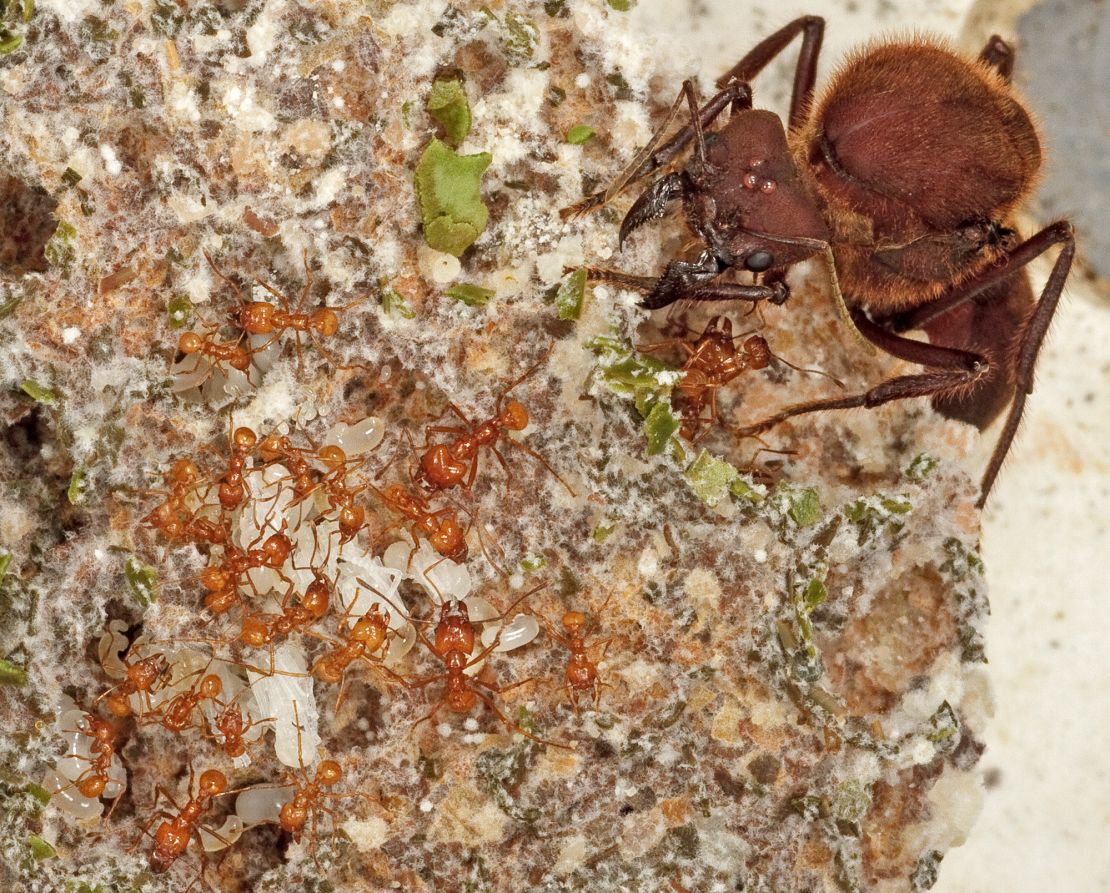Sign up for CNN’s Wonder Theory science newsletter. Explore the universe with news on fascinating discoveries, scientific advancements and more.
You have probably seen leaf-cutter ants carrying bits of plants, maybe in a nature documentary, at a science museum or in the “Circle of Life” song at the beginning of the 1994 Disney animated film “The Lion King.”
Those ants don’t eat the leaves — instead they bring them back to their nests to feed a garden of fungi, which produce food for the ants.
Researchers have now used DNA analysis to uncover just how long ants have been farming fungi, now described in a study published Thursday in the journal Science. It turns out these insects have been some of the world’s tiniest farmers for 66 million years, thanks in part to the asteroid that struck Earth and set off a chain of events that led to the demise of the dinosaurs.
Fungi are a kingdom of life more closely related to animals than to plants, and many of them consume decaying plant matter. Some fungi make fruiting bodies that we know as mushrooms as part of their reproductive cycles, but they also produce a branching network of threadlike structures called hyphae. Exactly 150 years ago, scientists first discovered that leaf-cutter ants were cultivating gardens of fungi inside their nests, feeding the fungi bits of leaves and in turn eating the tips of the fungal webs.
“Ants practice agriculture just like humans,” said lead study author Dr. Ted R. Schultz, a research entomologist and curator of hymenoptera at the Smithsonian National Museum of Natural History in Washington, DC. “They have small brains, and yet they manage to carry out this complicated suite of behaviors.”
A better understanding of ant farming practices that have benefited both the insects and the fungi for ages could also one day help humans develop more effective agricultural methods, according to Schultz.
Ant farmers tend fungus gardens
Schultz has been studying fungus-farming ants, including leaf-cutters, for more than 35 years to try to figure out how this unusual behavior evolved.
To trace the evolution of this relationship between ants and fungi, Schultz and his colleagues built complex family trees. Using the DNA from 475 species of fungi, including 288 species known to be cultivated by ants, the researchers pieced together how all these organisms are related. The study team did the same thing for 276 species of ants, including 208 species of fungus farmers.

The family trees are based on how similar or dissimilar the different species’ genomes are, and the lengths of the tree branches are dictated by how much genetic change there is from one species to another. These genetic differences are often linked to time, with more variation requiring more time to evolve. By combining each family tree with rare fossils of fungi and ants, respectively, the scientists were able to ascertain how long ago the ants and fungi branched into the families and species alive today.
The researchers found that the ancestors of the modern ant-grown fungi began evolving 66 million years ago — the same time that a massive asteroid collided with what’s now the Yucatán Peninsula in Chicxulub, Mexico. The cloud of dust from the impact blotted out the sunlight, causing a dramatic die-off of plants and animals, including the dinosaurs (except for birds). But this destruction and decay appear to have been a golden opportunity for fungi that decomposed the dead plants.
“There’s actually evidence that fungi proliferated briefly right after the end of the Cretaceous-Paleogene event,” Schultz said.
The ancestors of modern leaf-cutters and other fungus-farming ants also diversified around this time, and they appeared to evolve in tandem with the fungi over the years to the point that some ants “domesticated” species of fungi that today are only found in the ants’ nests.
Dr. Corrie Moreau, a professor of entomology and evolutionary biology at Cornell University in upstate New York, agreed with Schultz’s hypothesis that the asteroid impact led to the evolution of fungus farming in ants.
“It’s one of those things that they can never prove unless we get a time machine, but they line up what’s happening with the fungi and the ants with what was happening globally,” said Moreau, who was not involved with the study. “You can see this almost one-to-one relationship.”
Mutually beneficial ties
This shared evolutionary history appears to have benefited both the ants and the fungi in what’s called mutualism. The ants get food, and the fungi get room and board, plus careful tending by the ants and the chance to spread as the insects stake out new territory.
“When a daughter queen gets ready to leave her mother’s nest and start her own nest, she takes a little bit of her mother’s fungus in her mouth,” Schultz said.
The ants and fungi help each other, but they might be able to help human farmers, too.
“Humans have been practicing agriculture for 12,000 years,” Schultz said. “Ants, for 66 million years.”
The ants employ helpful bacteria to keep their fungal crops healthy from disease and appear to have more success than human farmers often do with their crops.
“We’re constantly dealing with antibiotic resistance and trying to find new antibiotics to overcome that,” Schultz said. “If we could figure out how they’ve been doing that, I don’t see how that couldn’t inform the practice of human agriculture and improve it.”
Kate Golembiewski is a freelance science writer based in Chicago who geeks out about zoology, thermodynamics and death.






